Impact of Organizational Behaviour on John Lewis Company's Performance
VerifiedAdded on 2023/01/11
|16
|5195
|26
Report
AI Summary
This report provides a comprehensive analysis of the organizational behavior within John Lewis Company. It begins by exploring the impact of organizational culture, politics, and power dynamics on individual and team behavior, referencing Handy's cultural model and French and Raven's power model. The report then delves into motivational theories, including content and process theories, with a focus on Maslow's Hierarchy of Needs and Locke and Latham's goal-setting theory, and how these influence employee motivation and performance. Furthermore, it differentiates between effective and ineffective teams, discussing team development models. Finally, the report examines how organizational behavior concepts and philosophies influence the company's operations, concluding with the importance of culture and motivation in driving overall performance. The report highlights how these factors affect the company's performance and provides insights into improving employee engagement and productivity.
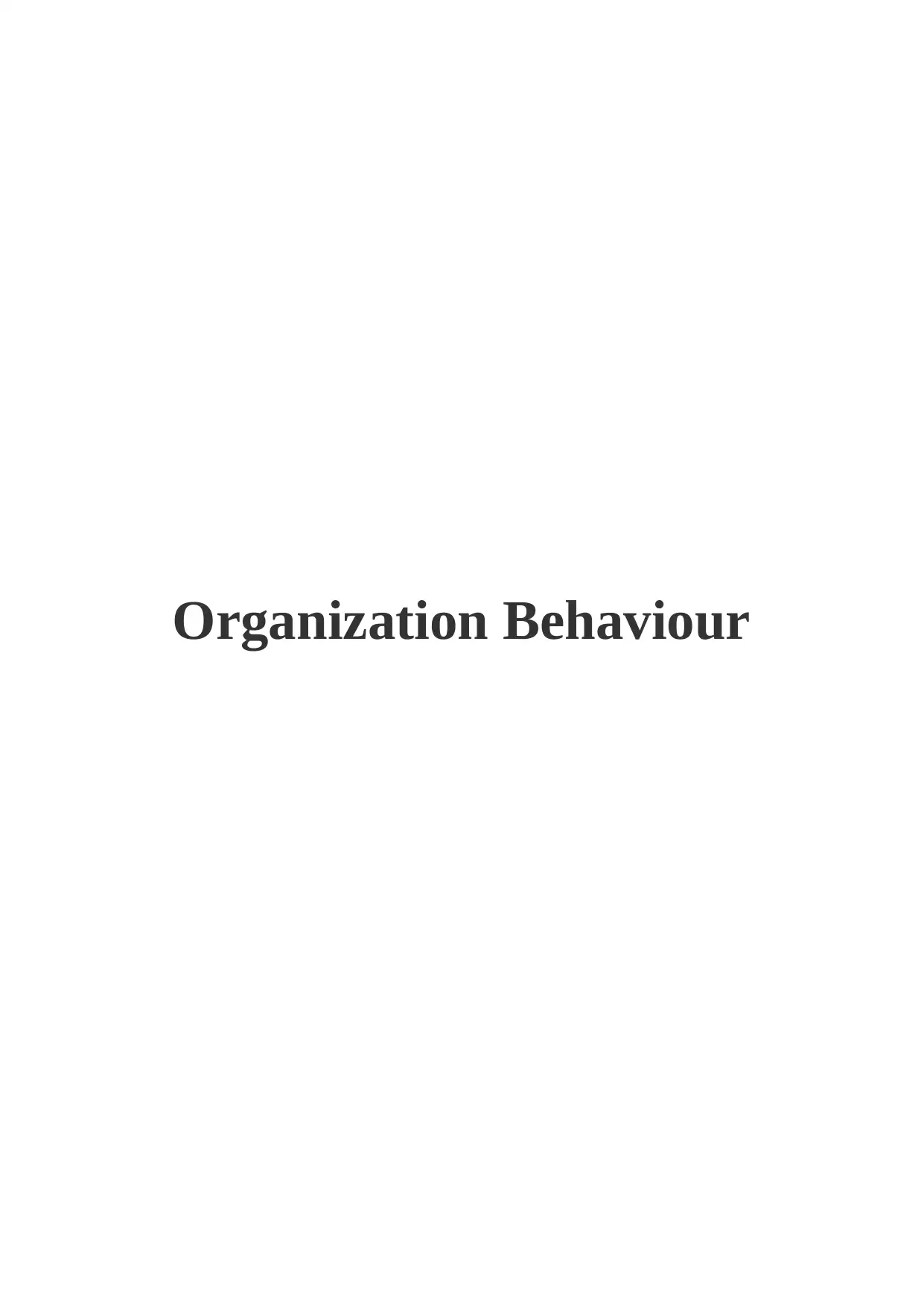
Organization Behaviour
Paraphrase This Document
Need a fresh take? Get an instant paraphrase of this document with our AI Paraphraser
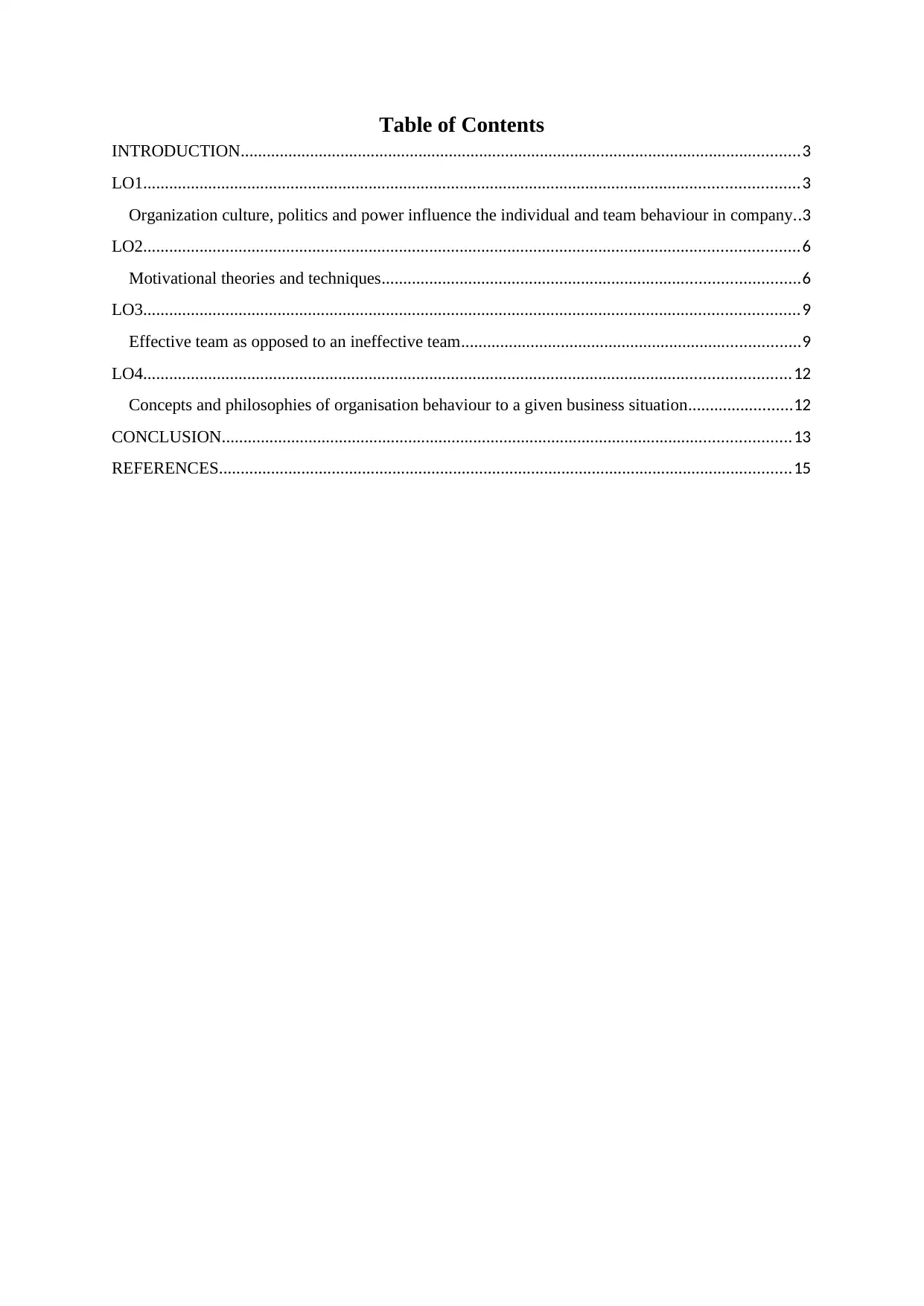
Table of Contents
INTRODUCTION.................................................................................................................................3
LO1.......................................................................................................................................................3
Organization culture, politics and power influence the individual and team behaviour in company..3
LO2.......................................................................................................................................................6
Motivational theories and techniques................................................................................................6
LO3.......................................................................................................................................................9
Effective team as opposed to an ineffective team..............................................................................9
LO4.....................................................................................................................................................12
Concepts and philosophies of organisation behaviour to a given business situation........................12
CONCLUSION...................................................................................................................................13
REFERENCES....................................................................................................................................15
INTRODUCTION.................................................................................................................................3
LO1.......................................................................................................................................................3
Organization culture, politics and power influence the individual and team behaviour in company..3
LO2.......................................................................................................................................................6
Motivational theories and techniques................................................................................................6
LO3.......................................................................................................................................................9
Effective team as opposed to an ineffective team..............................................................................9
LO4.....................................................................................................................................................12
Concepts and philosophies of organisation behaviour to a given business situation........................12
CONCLUSION...................................................................................................................................13
REFERENCES....................................................................................................................................15
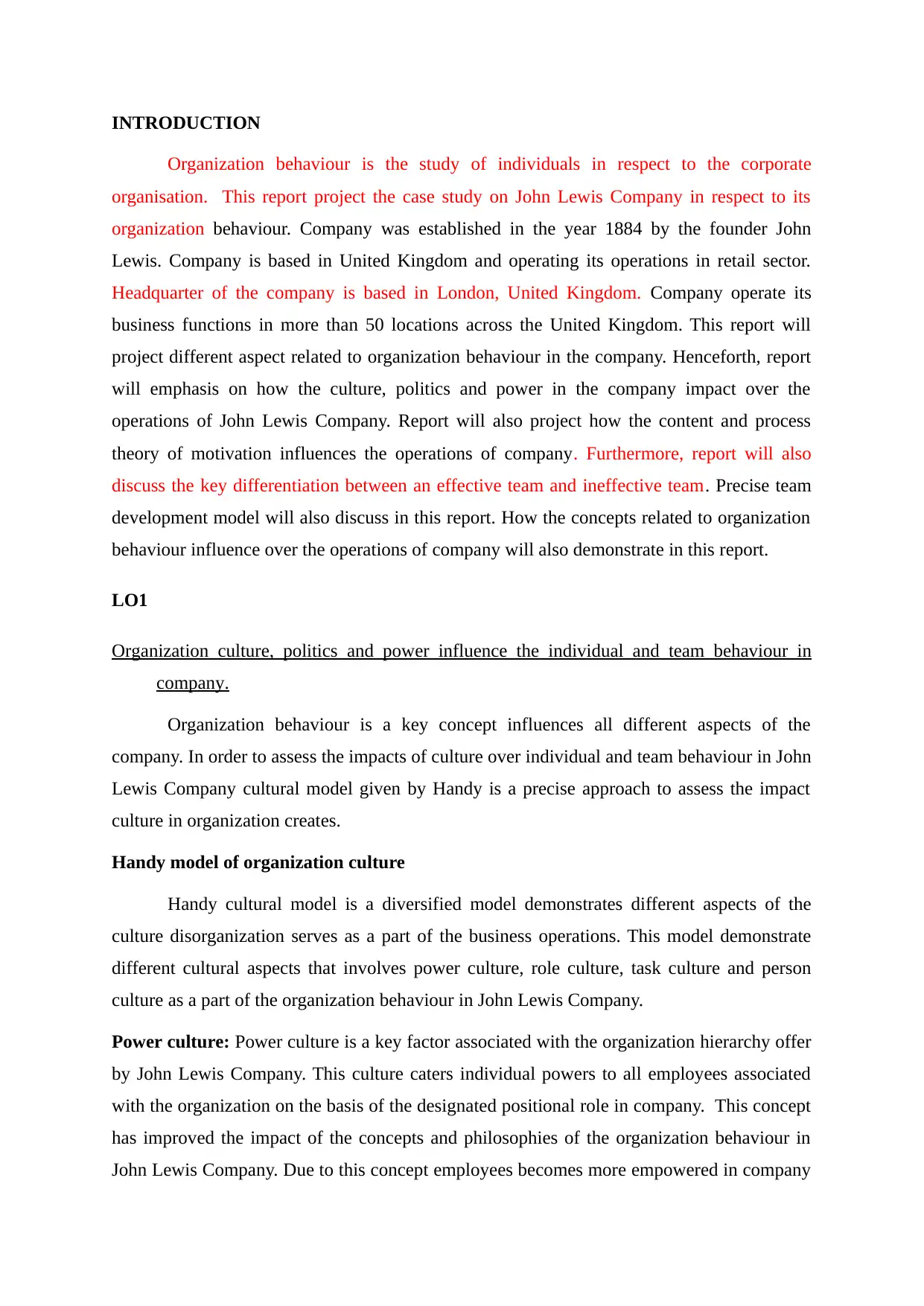
INTRODUCTION
Organization behaviour is the study of individuals in respect to the corporate
organisation. This report project the case study on John Lewis Company in respect to its
organization behaviour. Company was established in the year 1884 by the founder John
Lewis. Company is based in United Kingdom and operating its operations in retail sector.
Headquarter of the company is based in London, United Kingdom. Company operate its
business functions in more than 50 locations across the United Kingdom. This report will
project different aspect related to organization behaviour in the company. Henceforth, report
will emphasis on how the culture, politics and power in the company impact over the
operations of John Lewis Company. Report will also project how the content and process
theory of motivation influences the operations of company. Furthermore, report will also
discuss the key differentiation between an effective team and ineffective team. Precise team
development model will also discuss in this report. How the concepts related to organization
behaviour influence over the operations of company will also demonstrate in this report.
LO1
Organization culture, politics and power influence the individual and team behaviour in
company.
Organization behaviour is a key concept influences all different aspects of the
company. In order to assess the impacts of culture over individual and team behaviour in John
Lewis Company cultural model given by Handy is a precise approach to assess the impact
culture in organization creates.
Handy model of organization culture
Handy cultural model is a diversified model demonstrates different aspects of the
culture disorganization serves as a part of the business operations. This model demonstrate
different cultural aspects that involves power culture, role culture, task culture and person
culture as a part of the organization behaviour in John Lewis Company.
Power culture: Power culture is a key factor associated with the organization hierarchy offer
by John Lewis Company. This culture caters individual powers to all employees associated
with the organization on the basis of the designated positional role in company. This concept
has improved the impact of the concepts and philosophies of the organization behaviour in
John Lewis Company. Due to this concept employees becomes more empowered in company
Organization behaviour is the study of individuals in respect to the corporate
organisation. This report project the case study on John Lewis Company in respect to its
organization behaviour. Company was established in the year 1884 by the founder John
Lewis. Company is based in United Kingdom and operating its operations in retail sector.
Headquarter of the company is based in London, United Kingdom. Company operate its
business functions in more than 50 locations across the United Kingdom. This report will
project different aspect related to organization behaviour in the company. Henceforth, report
will emphasis on how the culture, politics and power in the company impact over the
operations of John Lewis Company. Report will also project how the content and process
theory of motivation influences the operations of company. Furthermore, report will also
discuss the key differentiation between an effective team and ineffective team. Precise team
development model will also discuss in this report. How the concepts related to organization
behaviour influence over the operations of company will also demonstrate in this report.
LO1
Organization culture, politics and power influence the individual and team behaviour in
company.
Organization behaviour is a key concept influences all different aspects of the
company. In order to assess the impacts of culture over individual and team behaviour in John
Lewis Company cultural model given by Handy is a precise approach to assess the impact
culture in organization creates.
Handy model of organization culture
Handy cultural model is a diversified model demonstrates different aspects of the
culture disorganization serves as a part of the business operations. This model demonstrate
different cultural aspects that involves power culture, role culture, task culture and person
culture as a part of the organization behaviour in John Lewis Company.
Power culture: Power culture is a key factor associated with the organization hierarchy offer
by John Lewis Company. This culture caters individual powers to all employees associated
with the organization on the basis of the designated positional role in company. This concept
has improved the impact of the concepts and philosophies of the organization behaviour in
John Lewis Company. Due to this concept employees becomes more empowered in company
⊘ This is a preview!⊘
Do you want full access?
Subscribe today to unlock all pages.

Trusted by 1+ million students worldwide
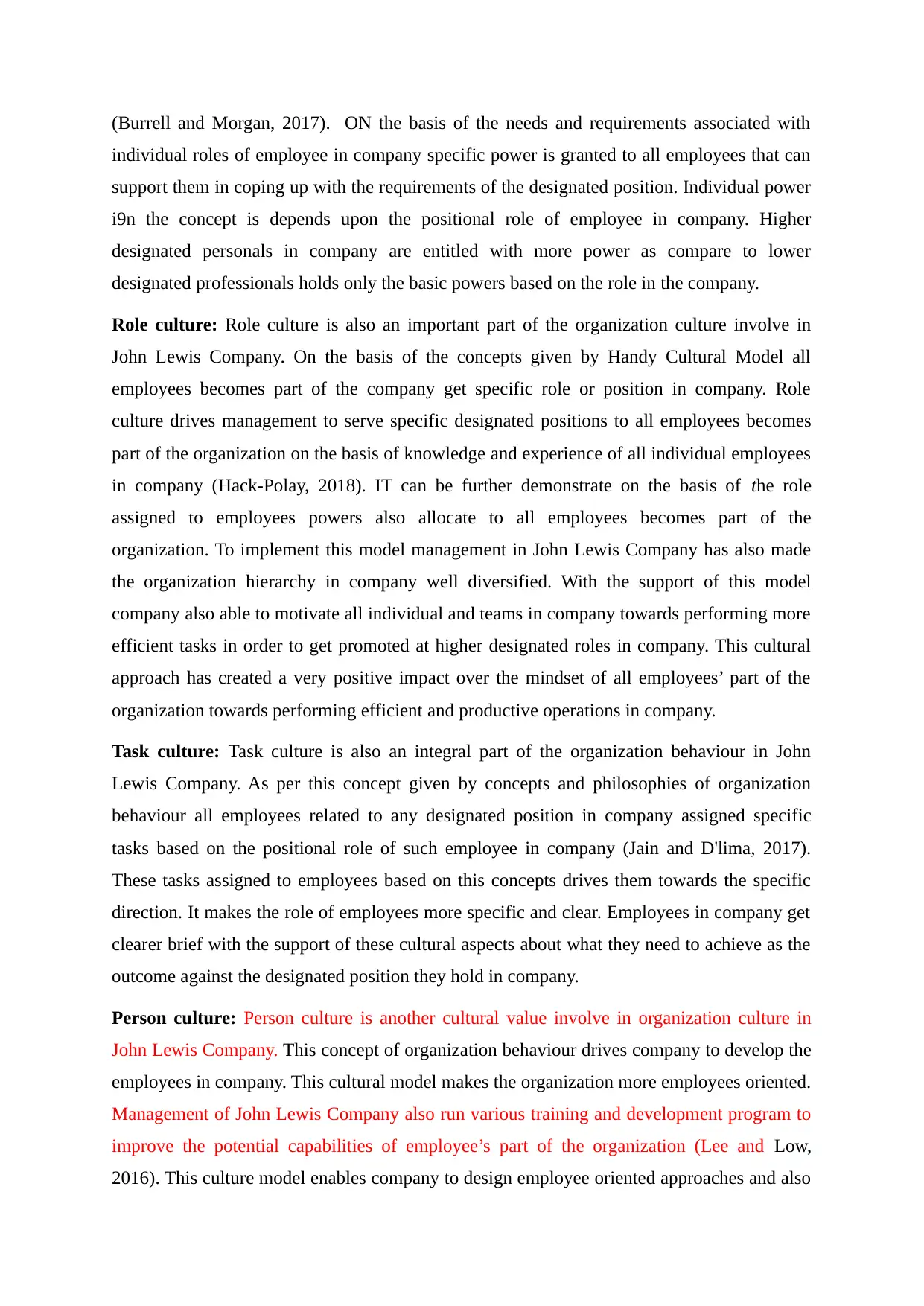
(Burrell and Morgan, 2017). ON the basis of the needs and requirements associated with
individual roles of employee in company specific power is granted to all employees that can
support them in coping up with the requirements of the designated position. Individual power
i9n the concept is depends upon the positional role of employee in company. Higher
designated personals in company are entitled with more power as compare to lower
designated professionals holds only the basic powers based on the role in the company.
Role culture: Role culture is also an important part of the organization culture involve in
John Lewis Company. On the basis of the concepts given by Handy Cultural Model all
employees becomes part of the company get specific role or position in company. Role
culture drives management to serve specific designated positions to all employees becomes
part of the organization on the basis of knowledge and experience of all individual employees
in company (Hack-Polay, 2018). IT can be further demonstrate on the basis of the role
assigned to employees powers also allocate to all employees becomes part of the
organization. To implement this model management in John Lewis Company has also made
the organization hierarchy in company well diversified. With the support of this model
company also able to motivate all individual and teams in company towards performing more
efficient tasks in order to get promoted at higher designated roles in company. This cultural
approach has created a very positive impact over the mindset of all employees’ part of the
organization towards performing efficient and productive operations in company.
Task culture: Task culture is also an integral part of the organization behaviour in John
Lewis Company. As per this concept given by concepts and philosophies of organization
behaviour all employees related to any designated position in company assigned specific
tasks based on the positional role of such employee in company (Jain and D'lima, 2017).
These tasks assigned to employees based on this concepts drives them towards the specific
direction. It makes the role of employees more specific and clear. Employees in company get
clearer brief with the support of these cultural aspects about what they need to achieve as the
outcome against the designated position they hold in company.
Person culture: Person culture is another cultural value involve in organization culture in
John Lewis Company. This concept of organization behaviour drives company to develop the
employees in company. This cultural model makes the organization more employees oriented.
Management of John Lewis Company also run various training and development program to
improve the potential capabilities of employee’s part of the organization (Lee and Low,
2016). This culture model enables company to design employee oriented approaches and also
individual roles of employee in company specific power is granted to all employees that can
support them in coping up with the requirements of the designated position. Individual power
i9n the concept is depends upon the positional role of employee in company. Higher
designated personals in company are entitled with more power as compare to lower
designated professionals holds only the basic powers based on the role in the company.
Role culture: Role culture is also an important part of the organization culture involve in
John Lewis Company. On the basis of the concepts given by Handy Cultural Model all
employees becomes part of the company get specific role or position in company. Role
culture drives management to serve specific designated positions to all employees becomes
part of the organization on the basis of knowledge and experience of all individual employees
in company (Hack-Polay, 2018). IT can be further demonstrate on the basis of the role
assigned to employees powers also allocate to all employees becomes part of the
organization. To implement this model management in John Lewis Company has also made
the organization hierarchy in company well diversified. With the support of this model
company also able to motivate all individual and teams in company towards performing more
efficient tasks in order to get promoted at higher designated roles in company. This cultural
approach has created a very positive impact over the mindset of all employees’ part of the
organization towards performing efficient and productive operations in company.
Task culture: Task culture is also an integral part of the organization behaviour in John
Lewis Company. As per this concept given by concepts and philosophies of organization
behaviour all employees related to any designated position in company assigned specific
tasks based on the positional role of such employee in company (Jain and D'lima, 2017).
These tasks assigned to employees based on this concepts drives them towards the specific
direction. It makes the role of employees more specific and clear. Employees in company get
clearer brief with the support of these cultural aspects about what they need to achieve as the
outcome against the designated position they hold in company.
Person culture: Person culture is another cultural value involve in organization culture in
John Lewis Company. This concept of organization behaviour drives company to develop the
employees in company. This cultural model makes the organization more employees oriented.
Management of John Lewis Company also run various training and development program to
improve the potential capabilities of employee’s part of the organization (Lee and Low,
2016). This culture model enables company to design employee oriented approaches and also
Paraphrase This Document
Need a fresh take? Get an instant paraphrase of this document with our AI Paraphraser
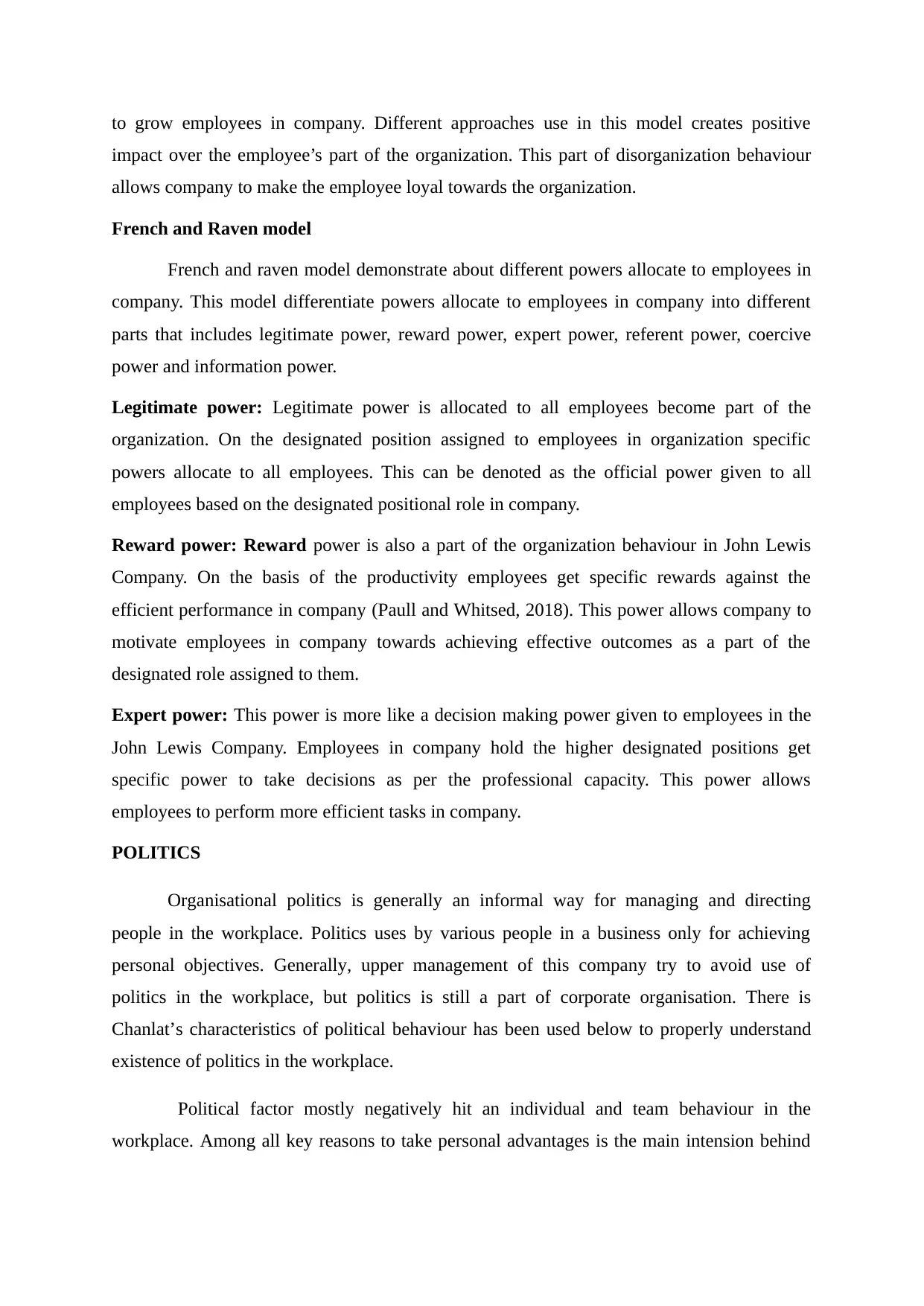
to grow employees in company. Different approaches use in this model creates positive
impact over the employee’s part of the organization. This part of disorganization behaviour
allows company to make the employee loyal towards the organization.
French and Raven model
French and raven model demonstrate about different powers allocate to employees in
company. This model differentiate powers allocate to employees in company into different
parts that includes legitimate power, reward power, expert power, referent power, coercive
power and information power.
Legitimate power: Legitimate power is allocated to all employees become part of the
organization. On the designated position assigned to employees in organization specific
powers allocate to all employees. This can be denoted as the official power given to all
employees based on the designated positional role in company.
Reward power: Reward power is also a part of the organization behaviour in John Lewis
Company. On the basis of the productivity employees get specific rewards against the
efficient performance in company (Paull and Whitsed, 2018). This power allows company to
motivate employees in company towards achieving effective outcomes as a part of the
designated role assigned to them.
Expert power: This power is more like a decision making power given to employees in the
John Lewis Company. Employees in company hold the higher designated positions get
specific power to take decisions as per the professional capacity. This power allows
employees to perform more efficient tasks in company.
POLITICS
Organisational politics is generally an informal way for managing and directing
people in the workplace. Politics uses by various people in a business only for achieving
personal objectives. Generally, upper management of this company try to avoid use of
politics in the workplace, but politics is still a part of corporate organisation. There is
Chanlat’s characteristics of political behaviour has been used below to properly understand
existence of politics in the workplace.
Political factor mostly negatively hit an individual and team behaviour in the
workplace. Among all key reasons to take personal advantages is the main intension behind
impact over the employee’s part of the organization. This part of disorganization behaviour
allows company to make the employee loyal towards the organization.
French and Raven model
French and raven model demonstrate about different powers allocate to employees in
company. This model differentiate powers allocate to employees in company into different
parts that includes legitimate power, reward power, expert power, referent power, coercive
power and information power.
Legitimate power: Legitimate power is allocated to all employees become part of the
organization. On the designated position assigned to employees in organization specific
powers allocate to all employees. This can be denoted as the official power given to all
employees based on the designated positional role in company.
Reward power: Reward power is also a part of the organization behaviour in John Lewis
Company. On the basis of the productivity employees get specific rewards against the
efficient performance in company (Paull and Whitsed, 2018). This power allows company to
motivate employees in company towards achieving effective outcomes as a part of the
designated role assigned to them.
Expert power: This power is more like a decision making power given to employees in the
John Lewis Company. Employees in company hold the higher designated positions get
specific power to take decisions as per the professional capacity. This power allows
employees to perform more efficient tasks in company.
POLITICS
Organisational politics is generally an informal way for managing and directing
people in the workplace. Politics uses by various people in a business only for achieving
personal objectives. Generally, upper management of this company try to avoid use of
politics in the workplace, but politics is still a part of corporate organisation. There is
Chanlat’s characteristics of political behaviour has been used below to properly understand
existence of politics in the workplace.
Political factor mostly negatively hit an individual and team behaviour in the
workplace. Among all key reasons to take personal advantages is the main intension behind
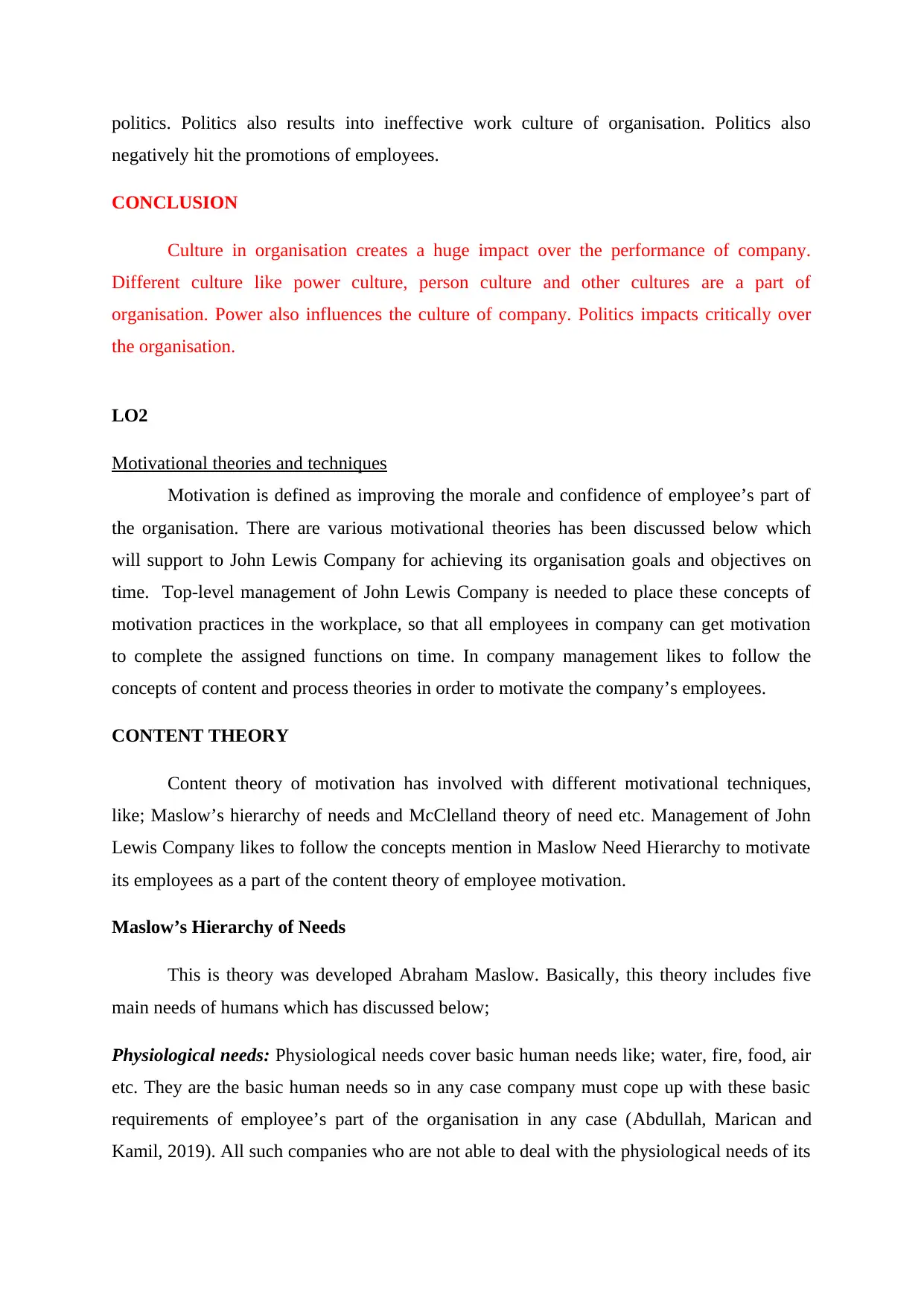
politics. Politics also results into ineffective work culture of organisation. Politics also
negatively hit the promotions of employees.
CONCLUSION
Culture in organisation creates a huge impact over the performance of company.
Different culture like power culture, person culture and other cultures are a part of
organisation. Power also influences the culture of company. Politics impacts critically over
the organisation.
LO2
Motivational theories and techniques
Motivation is defined as improving the morale and confidence of employee’s part of
the organisation. There are various motivational theories has been discussed below which
will support to John Lewis Company for achieving its organisation goals and objectives on
time. Top-level management of John Lewis Company is needed to place these concepts of
motivation practices in the workplace, so that all employees in company can get motivation
to complete the assigned functions on time. In company management likes to follow the
concepts of content and process theories in order to motivate the company’s employees.
CONTENT THEORY
Content theory of motivation has involved with different motivational techniques,
like; Maslow’s hierarchy of needs and McClelland theory of need etc. Management of John
Lewis Company likes to follow the concepts mention in Maslow Need Hierarchy to motivate
its employees as a part of the content theory of employee motivation.
Maslow’s Hierarchy of Needs
This is theory was developed Abraham Maslow. Basically, this theory includes five
main needs of humans which has discussed below;
Physiological needs: Physiological needs cover basic human needs like; water, fire, food, air
etc. They are the basic human needs so in any case company must cope up with these basic
requirements of employee’s part of the organisation in any case (Abdullah, Marican and
Kamil, 2019). All such companies who are not able to deal with the physiological needs of its
negatively hit the promotions of employees.
CONCLUSION
Culture in organisation creates a huge impact over the performance of company.
Different culture like power culture, person culture and other cultures are a part of
organisation. Power also influences the culture of company. Politics impacts critically over
the organisation.
LO2
Motivational theories and techniques
Motivation is defined as improving the morale and confidence of employee’s part of
the organisation. There are various motivational theories has been discussed below which
will support to John Lewis Company for achieving its organisation goals and objectives on
time. Top-level management of John Lewis Company is needed to place these concepts of
motivation practices in the workplace, so that all employees in company can get motivation
to complete the assigned functions on time. In company management likes to follow the
concepts of content and process theories in order to motivate the company’s employees.
CONTENT THEORY
Content theory of motivation has involved with different motivational techniques,
like; Maslow’s hierarchy of needs and McClelland theory of need etc. Management of John
Lewis Company likes to follow the concepts mention in Maslow Need Hierarchy to motivate
its employees as a part of the content theory of employee motivation.
Maslow’s Hierarchy of Needs
This is theory was developed Abraham Maslow. Basically, this theory includes five
main needs of humans which has discussed below;
Physiological needs: Physiological needs cover basic human needs like; water, fire, food, air
etc. They are the basic human needs so in any case company must cope up with these basic
requirements of employee’s part of the organisation in any case (Abdullah, Marican and
Kamil, 2019). All such companies who are not able to deal with the physiological needs of its
⊘ This is a preview!⊘
Do you want full access?
Subscribe today to unlock all pages.

Trusted by 1+ million students worldwide
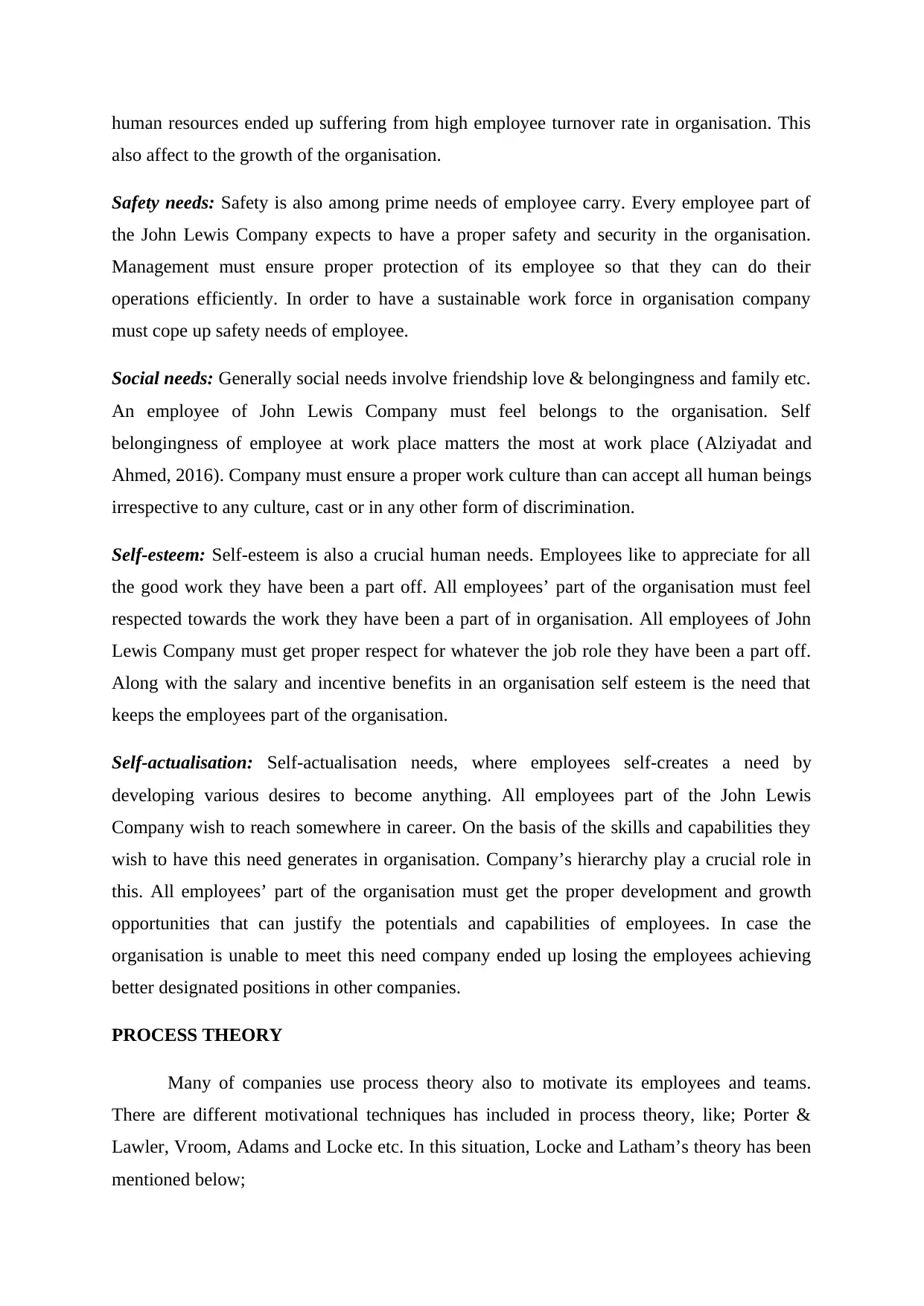
human resources ended up suffering from high employee turnover rate in organisation. This
also affect to the growth of the organisation.
Safety needs: Safety is also among prime needs of employee carry. Every employee part of
the John Lewis Company expects to have a proper safety and security in the organisation.
Management must ensure proper protection of its employee so that they can do their
operations efficiently. In order to have a sustainable work force in organisation company
must cope up safety needs of employee.
Social needs: Generally social needs involve friendship love & belongingness and family etc.
An employee of John Lewis Company must feel belongs to the organisation. Self
belongingness of employee at work place matters the most at work place (Alziyadat and
Ahmed, 2016). Company must ensure a proper work culture than can accept all human beings
irrespective to any culture, cast or in any other form of discrimination.
Self-esteem: Self-esteem is also a crucial human needs. Employees like to appreciate for all
the good work they have been a part off. All employees’ part of the organisation must feel
respected towards the work they have been a part of in organisation. All employees of John
Lewis Company must get proper respect for whatever the job role they have been a part off.
Along with the salary and incentive benefits in an organisation self esteem is the need that
keeps the employees part of the organisation.
Self-actualisation: Self-actualisation needs, where employees self-creates a need by
developing various desires to become anything. All employees part of the John Lewis
Company wish to reach somewhere in career. On the basis of the skills and capabilities they
wish to have this need generates in organisation. Company’s hierarchy play a crucial role in
this. All employees’ part of the organisation must get the proper development and growth
opportunities that can justify the potentials and capabilities of employees. In case the
organisation is unable to meet this need company ended up losing the employees achieving
better designated positions in other companies.
PROCESS THEORY
Many of companies use process theory also to motivate its employees and teams.
There are different motivational techniques has included in process theory, like; Porter &
Lawler, Vroom, Adams and Locke etc. In this situation, Locke and Latham’s theory has been
mentioned below;
also affect to the growth of the organisation.
Safety needs: Safety is also among prime needs of employee carry. Every employee part of
the John Lewis Company expects to have a proper safety and security in the organisation.
Management must ensure proper protection of its employee so that they can do their
operations efficiently. In order to have a sustainable work force in organisation company
must cope up safety needs of employee.
Social needs: Generally social needs involve friendship love & belongingness and family etc.
An employee of John Lewis Company must feel belongs to the organisation. Self
belongingness of employee at work place matters the most at work place (Alziyadat and
Ahmed, 2016). Company must ensure a proper work culture than can accept all human beings
irrespective to any culture, cast or in any other form of discrimination.
Self-esteem: Self-esteem is also a crucial human needs. Employees like to appreciate for all
the good work they have been a part off. All employees’ part of the organisation must feel
respected towards the work they have been a part of in organisation. All employees of John
Lewis Company must get proper respect for whatever the job role they have been a part off.
Along with the salary and incentive benefits in an organisation self esteem is the need that
keeps the employees part of the organisation.
Self-actualisation: Self-actualisation needs, where employees self-creates a need by
developing various desires to become anything. All employees part of the John Lewis
Company wish to reach somewhere in career. On the basis of the skills and capabilities they
wish to have this need generates in organisation. Company’s hierarchy play a crucial role in
this. All employees’ part of the organisation must get the proper development and growth
opportunities that can justify the potentials and capabilities of employees. In case the
organisation is unable to meet this need company ended up losing the employees achieving
better designated positions in other companies.
PROCESS THEORY
Many of companies use process theory also to motivate its employees and teams.
There are different motivational techniques has included in process theory, like; Porter &
Lawler, Vroom, Adams and Locke etc. In this situation, Locke and Latham’s theory has been
mentioned below;
Paraphrase This Document
Need a fresh take? Get an instant paraphrase of this document with our AI Paraphraser
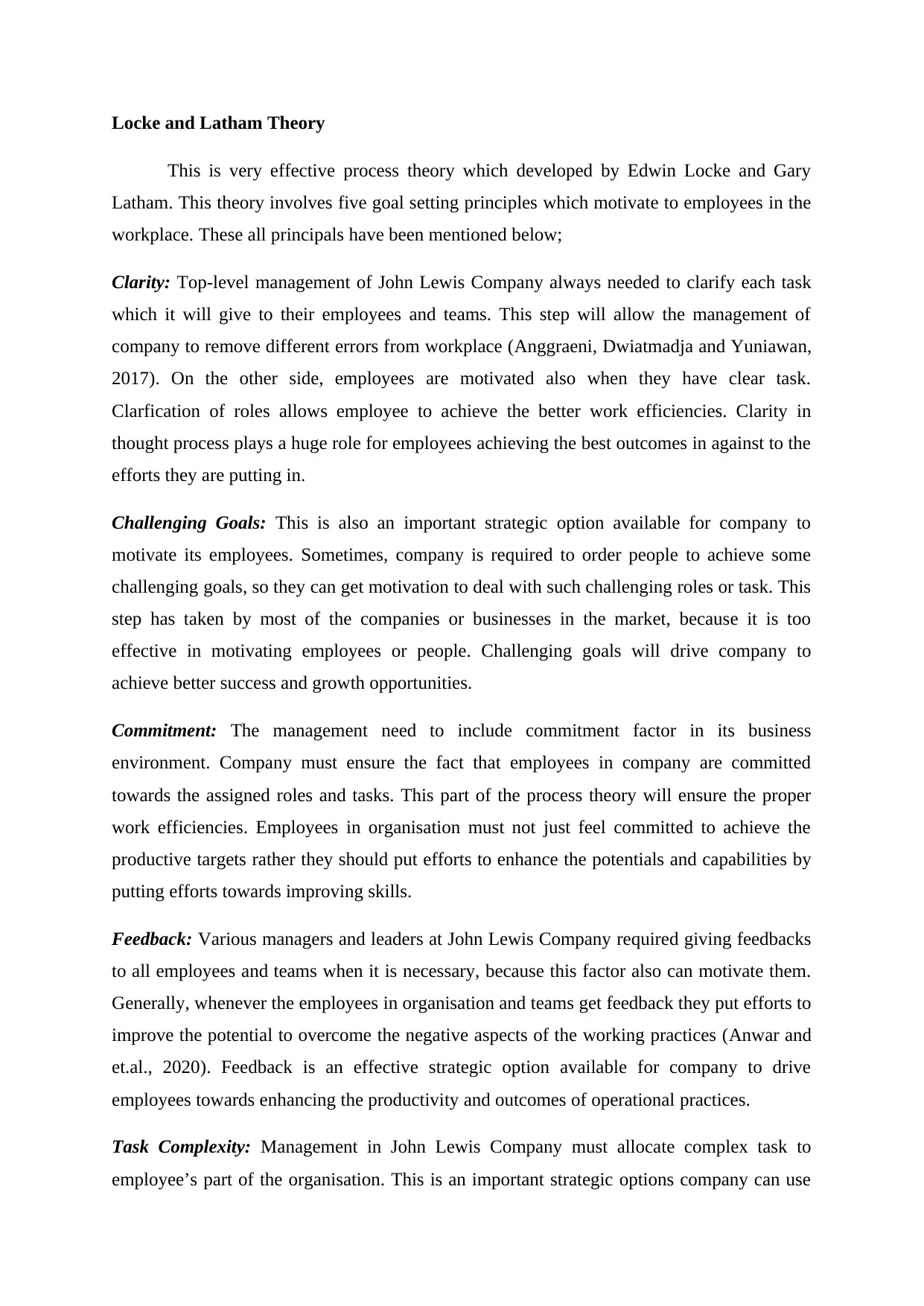
Locke and Latham Theory
This is very effective process theory which developed by Edwin Locke and Gary
Latham. This theory involves five goal setting principles which motivate to employees in the
workplace. These all principals have been mentioned below;
Clarity: Top-level management of John Lewis Company always needed to clarify each task
which it will give to their employees and teams. This step will allow the management of
company to remove different errors from workplace (Anggraeni, Dwiatmadja and Yuniawan,
2017). On the other side, employees are motivated also when they have clear task.
Clarfication of roles allows employee to achieve the better work efficiencies. Clarity in
thought process plays a huge role for employees achieving the best outcomes in against to the
efforts they are putting in.
Challenging Goals: This is also an important strategic option available for company to
motivate its employees. Sometimes, company is required to order people to achieve some
challenging goals, so they can get motivation to deal with such challenging roles or task. This
step has taken by most of the companies or businesses in the market, because it is too
effective in motivating employees or people. Challenging goals will drive company to
achieve better success and growth opportunities.
Commitment: The management need to include commitment factor in its business
environment. Company must ensure the fact that employees in company are committed
towards the assigned roles and tasks. This part of the process theory will ensure the proper
work efficiencies. Employees in organisation must not just feel committed to achieve the
productive targets rather they should put efforts to enhance the potentials and capabilities by
putting efforts towards improving skills.
Feedback: Various managers and leaders at John Lewis Company required giving feedbacks
to all employees and teams when it is necessary, because this factor also can motivate them.
Generally, whenever the employees in organisation and teams get feedback they put efforts to
improve the potential to overcome the negative aspects of the working practices (Anwar and
et.al., 2020). Feedback is an effective strategic option available for company to drive
employees towards enhancing the productivity and outcomes of operational practices.
Task Complexity: Management in John Lewis Company must allocate complex task to
employee’s part of the organisation. This is an important strategic options company can use
This is very effective process theory which developed by Edwin Locke and Gary
Latham. This theory involves five goal setting principles which motivate to employees in the
workplace. These all principals have been mentioned below;
Clarity: Top-level management of John Lewis Company always needed to clarify each task
which it will give to their employees and teams. This step will allow the management of
company to remove different errors from workplace (Anggraeni, Dwiatmadja and Yuniawan,
2017). On the other side, employees are motivated also when they have clear task.
Clarfication of roles allows employee to achieve the better work efficiencies. Clarity in
thought process plays a huge role for employees achieving the best outcomes in against to the
efforts they are putting in.
Challenging Goals: This is also an important strategic option available for company to
motivate its employees. Sometimes, company is required to order people to achieve some
challenging goals, so they can get motivation to deal with such challenging roles or task. This
step has taken by most of the companies or businesses in the market, because it is too
effective in motivating employees or people. Challenging goals will drive company to
achieve better success and growth opportunities.
Commitment: The management need to include commitment factor in its business
environment. Company must ensure the fact that employees in company are committed
towards the assigned roles and tasks. This part of the process theory will ensure the proper
work efficiencies. Employees in organisation must not just feel committed to achieve the
productive targets rather they should put efforts to enhance the potentials and capabilities by
putting efforts towards improving skills.
Feedback: Various managers and leaders at John Lewis Company required giving feedbacks
to all employees and teams when it is necessary, because this factor also can motivate them.
Generally, whenever the employees in organisation and teams get feedback they put efforts to
improve the potential to overcome the negative aspects of the working practices (Anwar and
et.al., 2020). Feedback is an effective strategic option available for company to drive
employees towards enhancing the productivity and outcomes of operational practices.
Task Complexity: Management in John Lewis Company must allocate complex task to
employee’s part of the organisation. This is an important strategic options company can use
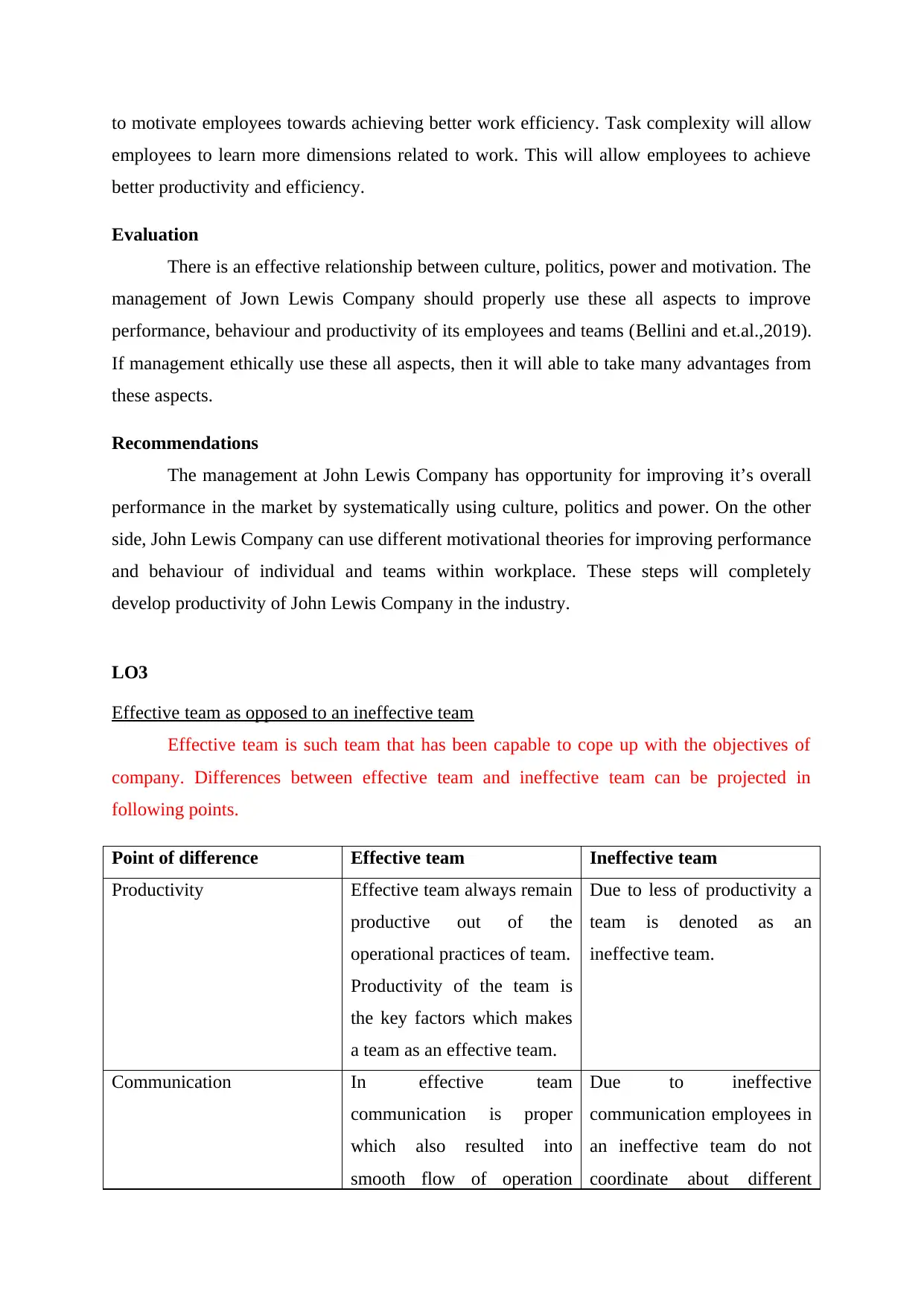
to motivate employees towards achieving better work efficiency. Task complexity will allow
employees to learn more dimensions related to work. This will allow employees to achieve
better productivity and efficiency.
Evaluation
There is an effective relationship between culture, politics, power and motivation. The
management of Jown Lewis Company should properly use these all aspects to improve
performance, behaviour and productivity of its employees and teams (Bellini and et.al.,2019).
If management ethically use these all aspects, then it will able to take many advantages from
these aspects.
Recommendations
The management at John Lewis Company has opportunity for improving it’s overall
performance in the market by systematically using culture, politics and power. On the other
side, John Lewis Company can use different motivational theories for improving performance
and behaviour of individual and teams within workplace. These steps will completely
develop productivity of John Lewis Company in the industry.
LO3
Effective team as opposed to an ineffective team
Effective team is such team that has been capable to cope up with the objectives of
company. Differences between effective team and ineffective team can be projected in
following points.
Point of difference Effective team Ineffective team
Productivity Effective team always remain
productive out of the
operational practices of team.
Productivity of the team is
the key factors which makes
a team as an effective team.
Due to less of productivity a
team is denoted as an
ineffective team.
Communication In effective team
communication is proper
which also resulted into
smooth flow of operation
Due to ineffective
communication employees in
an ineffective team do not
coordinate about different
employees to learn more dimensions related to work. This will allow employees to achieve
better productivity and efficiency.
Evaluation
There is an effective relationship between culture, politics, power and motivation. The
management of Jown Lewis Company should properly use these all aspects to improve
performance, behaviour and productivity of its employees and teams (Bellini and et.al.,2019).
If management ethically use these all aspects, then it will able to take many advantages from
these aspects.
Recommendations
The management at John Lewis Company has opportunity for improving it’s overall
performance in the market by systematically using culture, politics and power. On the other
side, John Lewis Company can use different motivational theories for improving performance
and behaviour of individual and teams within workplace. These steps will completely
develop productivity of John Lewis Company in the industry.
LO3
Effective team as opposed to an ineffective team
Effective team is such team that has been capable to cope up with the objectives of
company. Differences between effective team and ineffective team can be projected in
following points.
Point of difference Effective team Ineffective team
Productivity Effective team always remain
productive out of the
operational practices of team.
Productivity of the team is
the key factors which makes
a team as an effective team.
Due to less of productivity a
team is denoted as an
ineffective team.
Communication In effective team
communication is proper
which also resulted into
smooth flow of operation
Due to ineffective
communication employees in
an ineffective team do not
coordinate about different
⊘ This is a preview!⊘
Do you want full access?
Subscribe today to unlock all pages.

Trusted by 1+ million students worldwide
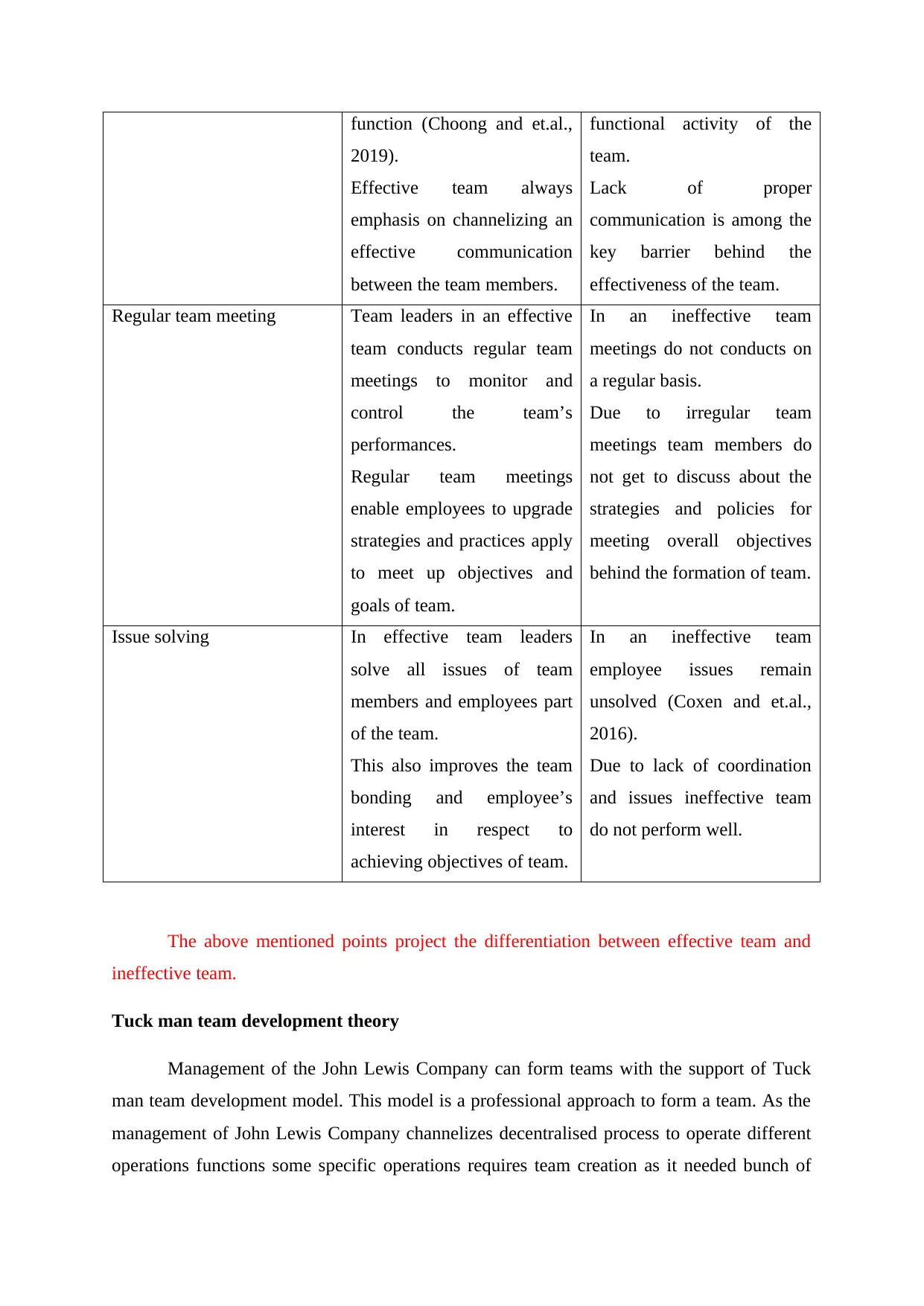
function (Choong and et.al.,
2019).
Effective team always
emphasis on channelizing an
effective communication
between the team members.
functional activity of the
team.
Lack of proper
communication is among the
key barrier behind the
effectiveness of the team.
Regular team meeting Team leaders in an effective
team conducts regular team
meetings to monitor and
control the team’s
performances.
Regular team meetings
enable employees to upgrade
strategies and practices apply
to meet up objectives and
goals of team.
In an ineffective team
meetings do not conducts on
a regular basis.
Due to irregular team
meetings team members do
not get to discuss about the
strategies and policies for
meeting overall objectives
behind the formation of team.
Issue solving In effective team leaders
solve all issues of team
members and employees part
of the team.
This also improves the team
bonding and employee’s
interest in respect to
achieving objectives of team.
In an ineffective team
employee issues remain
unsolved (Coxen and et.al.,
2016).
Due to lack of coordination
and issues ineffective team
do not perform well.
The above mentioned points project the differentiation between effective team and
ineffective team.
Tuck man team development theory
Management of the John Lewis Company can form teams with the support of Tuck
man team development model. This model is a professional approach to form a team. As the
management of John Lewis Company channelizes decentralised process to operate different
operations functions some specific operations requires team creation as it needed bunch of
2019).
Effective team always
emphasis on channelizing an
effective communication
between the team members.
functional activity of the
team.
Lack of proper
communication is among the
key barrier behind the
effectiveness of the team.
Regular team meeting Team leaders in an effective
team conducts regular team
meetings to monitor and
control the team’s
performances.
Regular team meetings
enable employees to upgrade
strategies and practices apply
to meet up objectives and
goals of team.
In an ineffective team
meetings do not conducts on
a regular basis.
Due to irregular team
meetings team members do
not get to discuss about the
strategies and policies for
meeting overall objectives
behind the formation of team.
Issue solving In effective team leaders
solve all issues of team
members and employees part
of the team.
This also improves the team
bonding and employee’s
interest in respect to
achieving objectives of team.
In an ineffective team
employee issues remain
unsolved (Coxen and et.al.,
2016).
Due to lack of coordination
and issues ineffective team
do not perform well.
The above mentioned points project the differentiation between effective team and
ineffective team.
Tuck man team development theory
Management of the John Lewis Company can form teams with the support of Tuck
man team development model. This model is a professional approach to form a team. As the
management of John Lewis Company channelizes decentralised process to operate different
operations functions some specific operations requires team creation as it needed bunch of
Paraphrase This Document
Need a fresh take? Get an instant paraphrase of this document with our AI Paraphraser
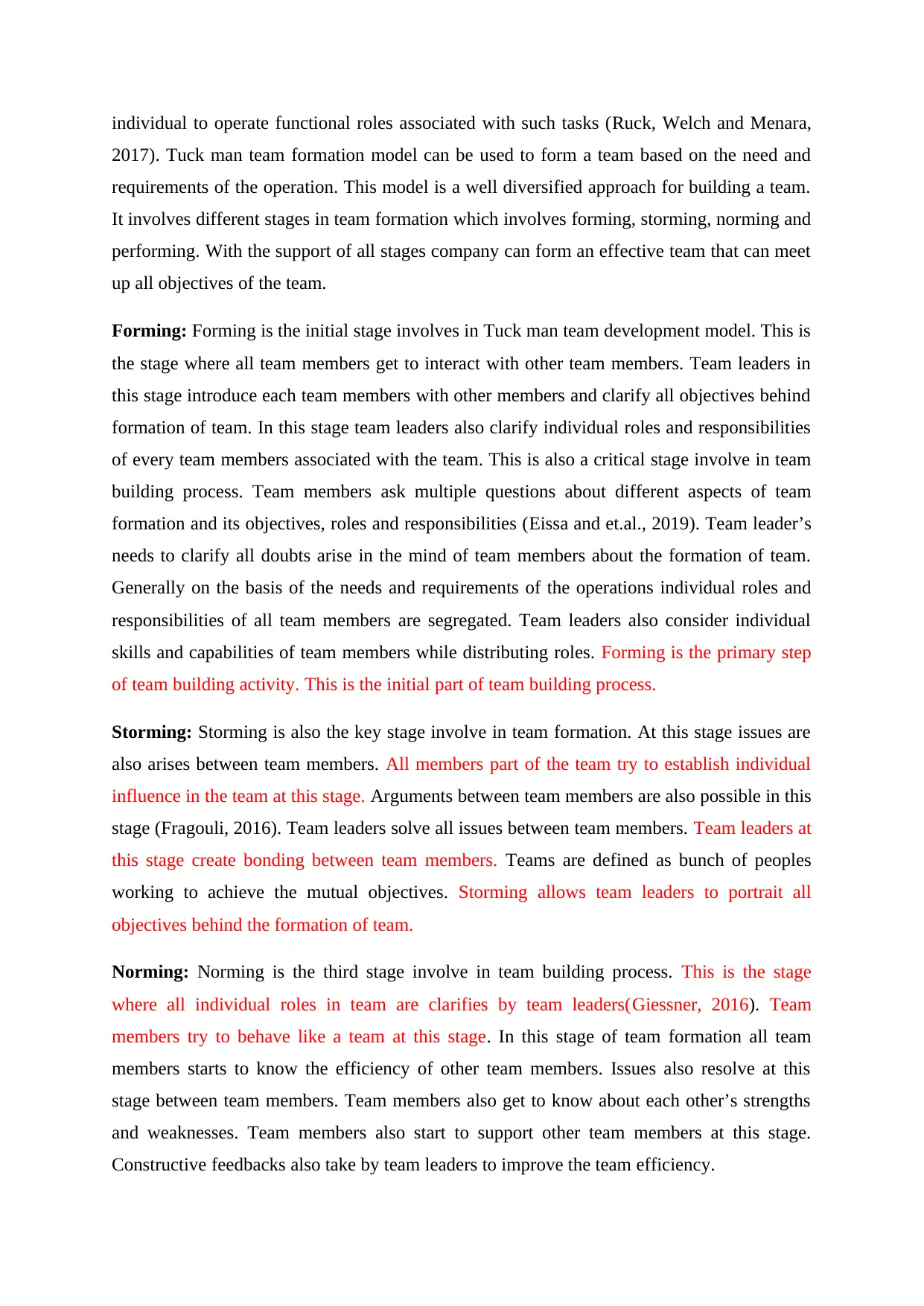
individual to operate functional roles associated with such tasks (Ruck, Welch and Menara,
2017). Tuck man team formation model can be used to form a team based on the need and
requirements of the operation. This model is a well diversified approach for building a team.
It involves different stages in team formation which involves forming, storming, norming and
performing. With the support of all stages company can form an effective team that can meet
up all objectives of the team.
Forming: Forming is the initial stage involves in Tuck man team development model. This is
the stage where all team members get to interact with other team members. Team leaders in
this stage introduce each team members with other members and clarify all objectives behind
formation of team. In this stage team leaders also clarify individual roles and responsibilities
of every team members associated with the team. This is also a critical stage involve in team
building process. Team members ask multiple questions about different aspects of team
formation and its objectives, roles and responsibilities (Eissa and et.al., 2019). Team leader’s
needs to clarify all doubts arise in the mind of team members about the formation of team.
Generally on the basis of the needs and requirements of the operations individual roles and
responsibilities of all team members are segregated. Team leaders also consider individual
skills and capabilities of team members while distributing roles. Forming is the primary step
of team building activity. This is the initial part of team building process.
Storming: Storming is also the key stage involve in team formation. At this stage issues are
also arises between team members. All members part of the team try to establish individual
influence in the team at this stage. Arguments between team members are also possible in this
stage (Fragouli, 2016). Team leaders solve all issues between team members. Team leaders at
this stage create bonding between team members. Teams are defined as bunch of peoples
working to achieve the mutual objectives. Storming allows team leaders to portrait all
objectives behind the formation of team.
Norming: Norming is the third stage involve in team building process. This is the stage
where all individual roles in team are clarifies by team leaders(Giessner, 2016). Team
members try to behave like a team at this stage. In this stage of team formation all team
members starts to know the efficiency of other team members. Issues also resolve at this
stage between team members. Team members also get to know about each other’s strengths
and weaknesses. Team members also start to support other team members at this stage.
Constructive feedbacks also take by team leaders to improve the team efficiency.
2017). Tuck man team formation model can be used to form a team based on the need and
requirements of the operation. This model is a well diversified approach for building a team.
It involves different stages in team formation which involves forming, storming, norming and
performing. With the support of all stages company can form an effective team that can meet
up all objectives of the team.
Forming: Forming is the initial stage involves in Tuck man team development model. This is
the stage where all team members get to interact with other team members. Team leaders in
this stage introduce each team members with other members and clarify all objectives behind
formation of team. In this stage team leaders also clarify individual roles and responsibilities
of every team members associated with the team. This is also a critical stage involve in team
building process. Team members ask multiple questions about different aspects of team
formation and its objectives, roles and responsibilities (Eissa and et.al., 2019). Team leader’s
needs to clarify all doubts arise in the mind of team members about the formation of team.
Generally on the basis of the needs and requirements of the operations individual roles and
responsibilities of all team members are segregated. Team leaders also consider individual
skills and capabilities of team members while distributing roles. Forming is the primary step
of team building activity. This is the initial part of team building process.
Storming: Storming is also the key stage involve in team formation. At this stage issues are
also arises between team members. All members part of the team try to establish individual
influence in the team at this stage. Arguments between team members are also possible in this
stage (Fragouli, 2016). Team leaders solve all issues between team members. Team leaders at
this stage create bonding between team members. Teams are defined as bunch of peoples
working to achieve the mutual objectives. Storming allows team leaders to portrait all
objectives behind the formation of team.
Norming: Norming is the third stage involve in team building process. This is the stage
where all individual roles in team are clarifies by team leaders(Giessner, 2016). Team
members try to behave like a team at this stage. In this stage of team formation all team
members starts to know the efficiency of other team members. Issues also resolve at this
stage between team members. Team members also get to know about each other’s strengths
and weaknesses. Team members also start to support other team members at this stage.
Constructive feedbacks also take by team leaders to improve the team efficiency.
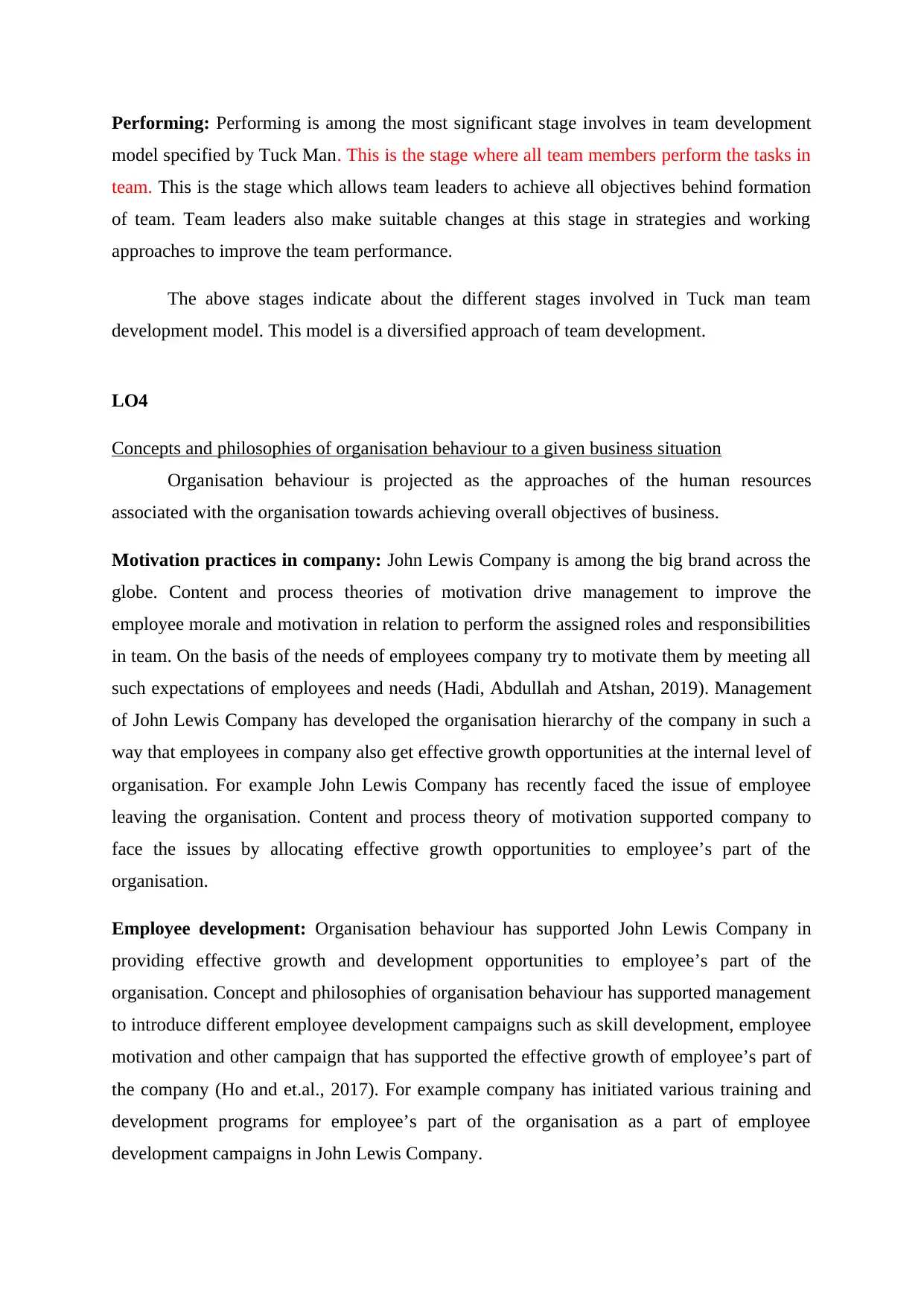
Performing: Performing is among the most significant stage involves in team development
model specified by Tuck Man. This is the stage where all team members perform the tasks in
team. This is the stage which allows team leaders to achieve all objectives behind formation
of team. Team leaders also make suitable changes at this stage in strategies and working
approaches to improve the team performance.
The above stages indicate about the different stages involved in Tuck man team
development model. This model is a diversified approach of team development.
LO4
Concepts and philosophies of organisation behaviour to a given business situation
Organisation behaviour is projected as the approaches of the human resources
associated with the organisation towards achieving overall objectives of business.
Motivation practices in company: John Lewis Company is among the big brand across the
globe. Content and process theories of motivation drive management to improve the
employee morale and motivation in relation to perform the assigned roles and responsibilities
in team. On the basis of the needs of employees company try to motivate them by meeting all
such expectations of employees and needs (Hadi, Abdullah and Atshan, 2019). Management
of John Lewis Company has developed the organisation hierarchy of the company in such a
way that employees in company also get effective growth opportunities at the internal level of
organisation. For example John Lewis Company has recently faced the issue of employee
leaving the organisation. Content and process theory of motivation supported company to
face the issues by allocating effective growth opportunities to employee’s part of the
organisation.
Employee development: Organisation behaviour has supported John Lewis Company in
providing effective growth and development opportunities to employee’s part of the
organisation. Concept and philosophies of organisation behaviour has supported management
to introduce different employee development campaigns such as skill development, employee
motivation and other campaign that has supported the effective growth of employee’s part of
the company (Ho and et.al., 2017). For example company has initiated various training and
development programs for employee’s part of the organisation as a part of employee
development campaigns in John Lewis Company.
model specified by Tuck Man. This is the stage where all team members perform the tasks in
team. This is the stage which allows team leaders to achieve all objectives behind formation
of team. Team leaders also make suitable changes at this stage in strategies and working
approaches to improve the team performance.
The above stages indicate about the different stages involved in Tuck man team
development model. This model is a diversified approach of team development.
LO4
Concepts and philosophies of organisation behaviour to a given business situation
Organisation behaviour is projected as the approaches of the human resources
associated with the organisation towards achieving overall objectives of business.
Motivation practices in company: John Lewis Company is among the big brand across the
globe. Content and process theories of motivation drive management to improve the
employee morale and motivation in relation to perform the assigned roles and responsibilities
in team. On the basis of the needs of employees company try to motivate them by meeting all
such expectations of employees and needs (Hadi, Abdullah and Atshan, 2019). Management
of John Lewis Company has developed the organisation hierarchy of the company in such a
way that employees in company also get effective growth opportunities at the internal level of
organisation. For example John Lewis Company has recently faced the issue of employee
leaving the organisation. Content and process theory of motivation supported company to
face the issues by allocating effective growth opportunities to employee’s part of the
organisation.
Employee development: Organisation behaviour has supported John Lewis Company in
providing effective growth and development opportunities to employee’s part of the
organisation. Concept and philosophies of organisation behaviour has supported management
to introduce different employee development campaigns such as skill development, employee
motivation and other campaign that has supported the effective growth of employee’s part of
the company (Ho and et.al., 2017). For example company has initiated various training and
development programs for employee’s part of the organisation as a part of employee
development campaigns in John Lewis Company.
⊘ This is a preview!⊘
Do you want full access?
Subscribe today to unlock all pages.

Trusted by 1+ million students worldwide
1 out of 16
Related Documents
Your All-in-One AI-Powered Toolkit for Academic Success.
+13062052269
info@desklib.com
Available 24*7 on WhatsApp / Email
![[object Object]](/_next/static/media/star-bottom.7253800d.svg)
Unlock your academic potential
Copyright © 2020–2025 A2Z Services. All Rights Reserved. Developed and managed by ZUCOL.





